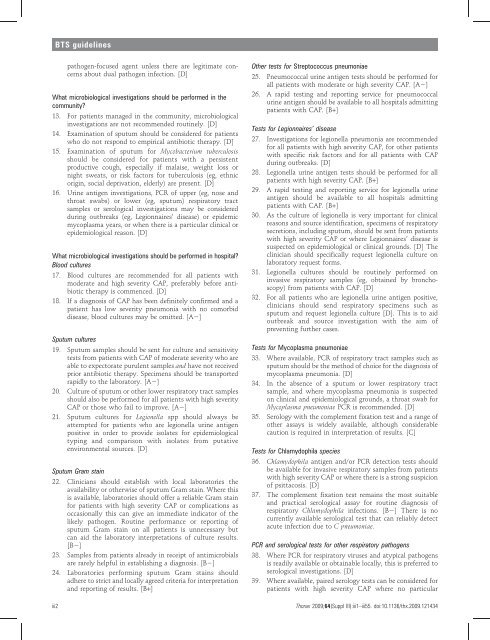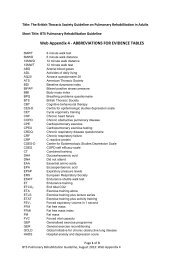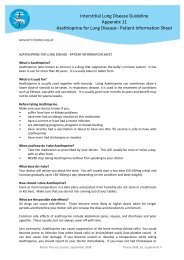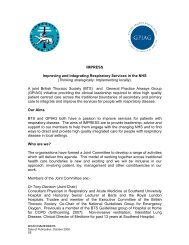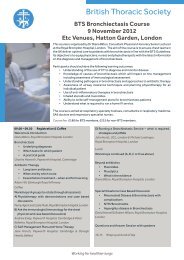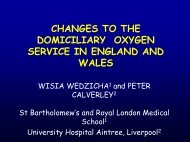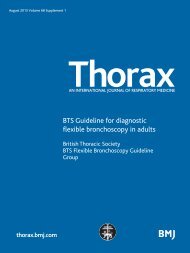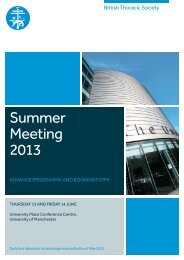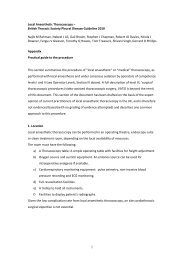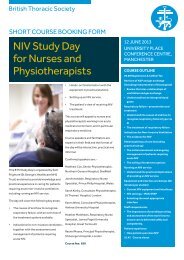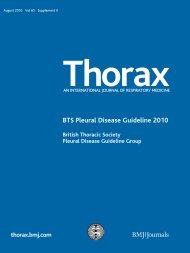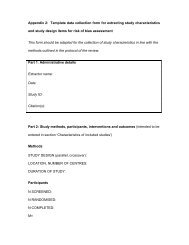Guidelines for the management of community ... - Brit Thoracic
Guidelines for the management of community ... - Brit Thoracic
Guidelines for the management of community ... - Brit Thoracic
Create successful ePaper yourself
Turn your PDF publications into a flip-book with our unique Google optimized e-Paper software.
BTS guidelines<br />
pathogen-focused agent unless <strong>the</strong>re are legitimate concerns<br />
about dual pathogen infection. [D]<br />
What microbiological investigations should be per<strong>for</strong>med in <strong>the</strong><br />
<strong>community</strong>?<br />
13. For patients managed in <strong>the</strong> <strong>community</strong>, microbiological<br />
investigations are not recommended routinely. [D]<br />
14. Examination <strong>of</strong> sputum should be considered <strong>for</strong> patients<br />
who do not respond to empirical antibiotic <strong>the</strong>rapy. [D]<br />
15. Examination <strong>of</strong> sputum <strong>for</strong> Mycobacterium tuberculosis<br />
should be considered <strong>for</strong> patients with a persistent<br />
productive cough, especially if malaise, weight loss or<br />
night sweats, or risk factors <strong>for</strong> tuberculosis (eg, ethnic<br />
origin, social deprivation, elderly) are present. [D]<br />
16. Urine antigen investigations, PCR <strong>of</strong> upper (eg, nose and<br />
throat swabs) or lower (eg, sputum) respiratory tract<br />
samples or serological investigations may be considered<br />
during outbreaks (eg, Legionnaires’ disease) or epidemic<br />
mycoplasma years, or when <strong>the</strong>re is a particular clinical or<br />
epidemiological reason. [D]<br />
What microbiological investigations should be per<strong>for</strong>med in hospital?<br />
Blood cultures<br />
17. Blood cultures are recommended <strong>for</strong> all patients with<br />
moderate and high severity CAP, preferably be<strong>for</strong>e antibiotic<br />
<strong>the</strong>rapy is commenced. [D]<br />
18. If a diagnosis <strong>of</strong> CAP has been definitely confirmed and a<br />
patient has low severity pneumonia with no comorbid<br />
disease, blood cultures may be omitted. [A2]<br />
Sputum cultures<br />
19. Sputum samples should be sent <strong>for</strong> culture and sensitivity<br />
tests from patients with CAP <strong>of</strong> moderate severity who are<br />
able to expectorate purulent samples and have not received<br />
prior antibiotic <strong>the</strong>rapy. Specimens should be transported<br />
rapidly to <strong>the</strong> laboratory. [A2]<br />
20. Culture <strong>of</strong> sputum or o<strong>the</strong>r lower respiratory tract samples<br />
should also be per<strong>for</strong>med <strong>for</strong> all patients with high severity<br />
CAP or those who fail to improve. [A2]<br />
21. Sputum cultures <strong>for</strong> Legionella spp should always be<br />
attempted <strong>for</strong> patients who are legionella urine antigen<br />
positive in order to provide isolates <strong>for</strong> epidemiological<br />
typing and comparison with isolates from putative<br />
environmental sources. [D]<br />
Sputum Gram stain<br />
22. Clinicians should establish with local laboratories <strong>the</strong><br />
availability or o<strong>the</strong>rwise <strong>of</strong> sputum Gram stain. Where this<br />
is available, laboratories should <strong>of</strong>fer a reliable Gram stain<br />
<strong>for</strong> patients with high severity CAP or complications as<br />
occasionally this can give an immediate indicator <strong>of</strong> <strong>the</strong><br />
likely pathogen. Routine per<strong>for</strong>mance or reporting <strong>of</strong><br />
sputum Gram stain on all patients is unnecessary but<br />
can aid <strong>the</strong> laboratory interpretations <strong>of</strong> culture results.<br />
[B2]<br />
23. Samples from patients already in receipt <strong>of</strong> antimicrobials<br />
are rarely helpful in establishing a diagnosis. [B2]<br />
24. Laboratories per<strong>for</strong>ming sputum Gram stains should<br />
adhere to strict and locally agreed criteria <strong>for</strong> interpretation<br />
and reporting <strong>of</strong> results. [B+]<br />
iii2<br />
O<strong>the</strong>r tests <strong>for</strong> Streptococcus pneumoniae<br />
25. Pneumococcal urine antigen tests should be per<strong>for</strong>med <strong>for</strong><br />
all patients with moderate or high severity CAP. [A2]<br />
26. A rapid testing and reporting service <strong>for</strong> pneumococcal<br />
urine antigen should be available to all hospitals admitting<br />
patients with CAP. [B+]<br />
Tests <strong>for</strong> Legionnaires’ disease<br />
27. Investigations <strong>for</strong> legionella pneumonia are recommended<br />
<strong>for</strong> all patients with high severity CAP, <strong>for</strong> o<strong>the</strong>r patients<br />
with specific risk factors and <strong>for</strong> all patients with CAP<br />
during outbreaks. [D]<br />
28. Legionella urine antigen tests should be per<strong>for</strong>med <strong>for</strong> all<br />
patients with high severity CAP. [B+]<br />
29. A rapid testing and reporting service <strong>for</strong> legionella urine<br />
antigen should be available to all hospitals admitting<br />
patients with CAP. [B+]<br />
30. As <strong>the</strong> culture <strong>of</strong> legionella is very important <strong>for</strong> clinical<br />
reasons and source identification, specimens <strong>of</strong> respiratory<br />
secretions, including sputum, should be sent from patients<br />
with high severity CAP or where Legionnaires’ disease is<br />
suspected on epidemiological or clinical grounds. [D] The<br />
clinician should specifically request legionella culture on<br />
laboratory request <strong>for</strong>ms.<br />
31. Legionella cultures should be routinely per<strong>for</strong>med on<br />
invasive respiratory samples (eg, obtained by bronchoscopy)<br />
from patients with CAP. [D]<br />
32. For all patients who are legionella urine antigen positive,<br />
clinicians should send respiratory specimens such as<br />
sputum and request legionella culture [D]. This is to aid<br />
outbreak and source investigation with <strong>the</strong> aim <strong>of</strong><br />
preventing fur<strong>the</strong>r cases.<br />
Tests <strong>for</strong> Mycoplasma pneumoniae<br />
33. Where available, PCR <strong>of</strong> respiratory tract samples such as<br />
sputum should be <strong>the</strong> method <strong>of</strong> choice <strong>for</strong> <strong>the</strong> diagnosis <strong>of</strong><br />
mycoplasma pneumonia. [D]<br />
34. In <strong>the</strong> absence <strong>of</strong> a sputum or lower respiratory tract<br />
sample, and where mycoplasma pneumonia is suspected<br />
on clinical and epidemiological grounds, a throat swab <strong>for</strong><br />
Mycoplasma pneumoniae PCR is recommended. [D]<br />
35. Serology with <strong>the</strong> complement fixation test and a range <strong>of</strong><br />
o<strong>the</strong>r assays is widely available, although considerable<br />
caution is required in interpretation <strong>of</strong> results. [C]<br />
Tests <strong>for</strong> Chlamydophila species<br />
36. Chlamydophila antigen and/or PCR detection tests should<br />
be available <strong>for</strong> invasive respiratory samples from patients<br />
with high severity CAP or where <strong>the</strong>re is a strong suspicion<br />
<strong>of</strong> psittacosis. [D]<br />
37. The complement fixation test remains <strong>the</strong> most suitable<br />
and practical serological assay <strong>for</strong> routine diagnosis <strong>of</strong><br />
respiratory Chlamydophila infections. [B2] There is no<br />
currently available serological test that can reliably detect<br />
acute infection due to C pneumoniae.<br />
PCR and serological tests <strong>for</strong> o<strong>the</strong>r respiratory pathogens<br />
38. Where PCR <strong>for</strong> respiratory viruses and atypical pathogens<br />
is readily available or obtainable locally, this is preferred to<br />
serological investigations. [D]<br />
39. Where available, paired serology tests can be considered <strong>for</strong><br />
patients with high severity CAP where no particular<br />
Thorax 2009;64(Suppl III):iii1–iii55. doi:10.1136/thx.2009.121434


